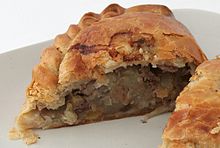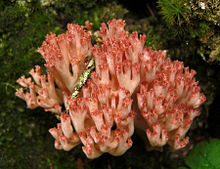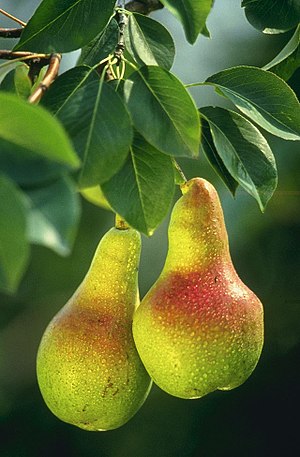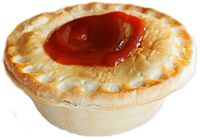Portal:Food
F o o d
A portal dedicated to food and foodways
Introduction


Food is any substance consumed by an organism for nutritional support. Food is usually of plant, animal, or fungal origin and contains essential nutrients such as carbohydrates, fats, proteins, vitamins, or minerals. The substance is ingested by an organism and assimilated by the organism's cells to provide energy, maintain life, or stimulate growth. Different species of animals have different feeding behaviours that satisfy the needs of their metabolisms and have evolved to fill a specific ecological niche within specific geographical contexts.
Omnivorous humans are highly adaptable and have adapted to obtain food in many different ecosystems. Humans generally use cooking to prepare food for consumption. The majority of the food energy required is supplied by the industrial food industry, which produces food through intensive agriculture and distributes it through complex food processing and food distribution systems. This system of conventional agriculture relies heavily on fossil fuels, which means that the food and agricultural systems are one of the major contributors to climate change, accounting for as much as 37% of total greenhouse gas emissions. (Full article...)
Cooking, also known as cookery or professionally as the culinary arts, is the art, science and craft of using heat to make food more palatable, digestible, nutritious, or safe. Cooking techniques and ingredients vary widely, from grilling food over an open fire, to using electric stoves, to baking in various types of ovens, reflecting local conditions. Cooking is an aspect of all human societies and a cultural universal.
Preparing food with heat or fire is an activity unique to humans. Archeological evidence of cooking fires from at least 300,000 years ago exists, but some estimate that humans started cooking up to 2 million years ago.
The expansion of agriculture, commerce, trade, and transportation between civilizations in different regions offered cooks many new ingredients. New inventions and technologies, such as the invention of pottery for holding and boiling of water, expanded cooking techniques. Some modern cooks apply advanced scientific techniques to food preparation to further enhance the flavor of the dish served. (Full article...)
Modern Cookery for Private Families is an English cookery book by Eliza Acton. It was first published by Longmans in 1845, and was a best-seller, running through 13 editions by 1853, though its sales were later overtaken by Mrs Beeton. On the strength of the book, Delia Smith called Acton "the best writer of recipes in the English language", while Elizabeth David wondered why "this peerless writer" had been eclipsed by such inferior and inexperienced imitators.
It was one of the first cookery books to provide lists of ingredients, exact quantities, and cooking times, and to include Eastern recipes for chutneys. (Full article...)
Selected article –

Conversations regarding the ethics of eating meat are focused on whether or not it is moral to eat non-human animals. Ultimately, this is a debate that has been ongoing for millennia, and it remains one of the most prominent topics in food ethics. Individuals who promote meat consumption do so for a number of reasons, such as health, cultural traditions, religious beliefs, and scientific arguments that support the practice. Those who support meat consumption typically argue that making a meat-free diet mandatory would be wrong because it fails to consider the individual nutritional needs of humans at various stages of life, fails to account for biological differences between the sexes, ignores the reality of human evolution, ignores various cultural considerations, or because it would limit the adaptability of the human species.
People who abstain from eating meat are generally known as "vegetarians". They avoid meat for various reasons such as taste preferences, religion, animal welfare, the environmental impact of meat production (environmental vegetarianism), health considerations, and antimicrobial resistance. Vegans also abstain from other animal products, such as dairy products, honey and eggs, for similar reasons. "Ethical omnivores" are individuals who object to the practices underlying the production of meat, as opposed to the act of consuming meat itself. In this respect, many people who abstain from certain kinds of meat eating and animal products do not take issue with meat consumption in general, provided that the meat and animal products are produced in a specific manner. Ethical omnivores may object to rearing animals for meat in factory farms, killing animals in ways that cause pain, and feeding animals unnecessary antibiotics or hormones. To this end, they may avoid meats such as veal, foie gras, meat from animals that were not free range, animals that were fed antibiotics or hormones, etc. (Full article...)Selected cuisine -

Cornish cuisine encompasses the cooking styles, traditions and recipes associated with Cornwall and the Cornish people. It has been heavily influenced by the geography of the county as well as its social history.
Cornwall, being a peninsula surrounded by seas historically well-stocked with fish, has meant that fish dishes form a major part of the historical and modern recipes in Cornwall. The fishing industry has played a major part in the economy of the county. The iconic dish of Cornwall, the pasty, has its roots in another historical industry within the county, this being mining. (Full article...)Selected ingredient –

In common usage, salt is a mineral composed primarily of sodium chloride (NaCl). When used in food, especially in granulated form, it is more formally called table salt. In the form of a natural crystalline mineral, salt is also known as rock salt or halite. Salt is essential for life in general, and saltiness is one of the basic human tastes. Salt is one of the oldest and most ubiquitous food seasonings, and is known to uniformly improve the taste perception of food, including otherwise unpalatable food. Salting, brining, and pickling are also ancient and important methods of food preservation.
Some of the earliest evidence of salt processing dates to around 6000 BC, when people living in the area of present-day Romania boiled spring water to extract salts; a salt works in China dates to approximately the same period. Salt was also prized by the ancient Hebrews, Greeks, Romans, Byzantines, Hittites, Egyptians, and Indians. Salt became an important article of trade and was transported by boat across the Mediterranean Sea, along specially built salt roads, and across the Sahara on camel caravans. The scarcity and universal need for salt have led nations to go to war over it and use it to raise tax revenues. Salt is used in religious ceremonies and has other cultural and traditional significance. (Full article...)
Selected recipe –
Kimchi (/ˈkɪmtʃiː/; Korean: 김치, romanized: gimchi, IPA: [kim.tɕʰi]) is a traditional Korean side dish (banchan) consisting of salted and fermented vegetables, most often napa cabbage or Korean radish. A wide selection of seasonings is used, including gochugaru (Korean chili powder), spring onions, garlic, ginger, and jeotgal (a salted seafood). Kimchi is also used in a variety of soups and stews. Kimchi is a staple food in Korean cuisine and is eaten as a side dish with almost every Korean meal.
There are hundreds of different types of kimchi made with different vegetables as the main ingredients. Traditionally, winter kimchi, called gimjang, was stored in large earthenware fermentation vessels, called onggi, in the ground to prevent freezing during the winter months and to keep it cool enough to slow down the fermentation process during summer months. The vessels are also kept outdoors in special terraces called jangdokdae. In contemporary times, household kimchi refrigerators are more commonly used. (Full article...)

Ramaria botrytis, commonly known as the clustered coral, the pink-tipped coral mushroom, or the cauliflower coral, is an edible species of coral fungus in the family Gomphaceae. Its robust fruit body can grow up to 15 cm (6 in) in diameter and 20 cm (8 in) tall, and resembles some marine coral. Its dense branches, which originate from a stout, massive base, are swollen at the tips and divided into several small branchlets. The branches are initially whitish but age to buff or tan, with tips that are pink to reddish. The flesh is thick and white. The spores, yellowish in deposit, are ellipsoid, feature longitudinal striations, and measure about 13.8 by 4.7 micrometers.
The type species of the genus Ramaria, R. botrytis was first described scientifically in 1797 by mycologist Christiaan Hendrik Persoon. A widely distributed species, it is found in North America, North Africa, central and eastern Europe, Australia, and Asia. The fungus is mycorrhizal with broadleaf trees, and fruits on the ground in wooded areas. There are several species of coral fungi that are superficially similar in appearance to R. botrytis, and although comparison of habitat or characteristics like color or branching morphology is often sufficient for identification, sometimes microscopy is required to definitively distinguish between them. Fruit bodies of Ramaria botrytis are edible, and young specimens have a mild, fruity taste. Some authors warn of laxative effects in susceptible individuals. The fungus contains several chemical compounds with in vitro biological activity, and fruit bodies have antimicrobial activity against several species and strains of drug-resistant bacteria that cause disease in humans. (Full article...)Selected image –
Selected biography –
Haddon Norman Salt (born 18 October 1928) is a British–American businessman, best known for founding the fast food chain H. Salt Esq. Fish & Chips and for acting as that company's brand ambassador, spokesman, and symbol. Salt followed his father and grandfather's careers, becoming a master fish cook and purveyor of fish and chips.
"I came over not simply to start a restaurant, but to introduce America to fish and chips, as grandiose as that dream sounds now". When Salt arrived in America in 1964, Britons ate an average of 100 pounds of fish per year, while Americans ate only 10 pounds per year. Salt said, "The way some of it is handled, I can see why".
Salt opened his first fish and chips shop in California in 1965. His business was acquired by the Kentucky Fried Chicken corporation in 1969. The sale made Salt the third largest stockholder in KFC, at the time the world's largest fast-food company.
KFC was not successful in the large-scale expansion of the H. Salt Esq. chain and sold the brand and business in 1972. Salt explained the brand's failure, saying "They started lowering the standards of the quality of the fish, and so the [sales] volumes of the restaurants went down and people stopped buying franchises, so that was the end of it. And it didn't grow anymore."
Salt left the company in 1972. (Full article...)
Did you know (auto-generated) –

- ... that a two-year-old food bank contributed 150 semi-trucks of supplies to relief efforts for Hurricane Katrina?
- ... that in countries like the United States, prisoners supplement inadequate prison food by combining ingredients like instant ramen, mayonnaise and Kool-Aid into improvised meals called "spreads"?
- ... that some fans of Genshin Impact have referred to the character Paimon as "emergency food"?
- ... that the fork-tailed drongo gives genuine alarm calls but will sometimes lie to steal food from other animals?
- ... that Rosalind Creasy wrote a landmark book on edible landscaping?
- ... that Miles Hadfield ensured supplies of food to Coventry during the Second World War Blitz?
More did you know –
Related portals
Food topics
The following are topics relating to food
Categories
Food list articles
- See also: Lists of foods and Category:Lists of drinks
The following are some Food list articles on Wikipedia:

- American cheeses
- Appellation d'Origine Contrôlée cheeses
- Apple cultivars
- Bacon dishes
- Bacon substitutes
- Basil cultivars
- Breads
- Breakfast beverages
- Breakfast cereals
- Breakfast foods
- British cheeses
- Cakes
- Candies
- Cheeses
- Cheese soups
- Christmas dishes (list)
- Cocktails
- Cookies
- Dishes using coconut milk
- Diets
- Doughnut varieties
- Egg dishes
- Fermented soy products
- Food additives
- Food additives (Codex Alimentarius)
- Foods named after people
- French cheeses
- French dishes
- Fried dough foods
- Fruits
- List of hamburgers
- Herbs and spices
- Hors d'oeuvre
- Indian dishes
- Indian snack foods
- Indonesian dishes
- Italian dishes
- Japanese snacks
- Japanese dishes
- Jewish dishes
- Kebabs
- Korean beverages
- Mango cultivars
- Moroccan dishes
- Pasta
- Pastries
- Philippine snack food
- Pies, tarts and flans
- Poppy seed pastries and dishes
- Potato dishes
- Puddings
- Raw fish dishes
- Rice dishes
- Rolled foods
- Sauces
- Seafood
- Seeds
- Sandwiches
- Snack foods
- Soft drinks by country
- Soul foods and dishes
- Soups
- Stews
- Street foods
- Tapas
- Turkish dishes
- Twice-baked foods
- Vegetable oils
- Vegetables
- Vodkas
Things you can do
Related WikiProjects
| Parent project: WikiProject Food and Drink | |
| Child projects: | Task forces: (All inactive) |
|
|
| Related projects: | |
New articles
Rules | Match log | Results page (for watching) | Last updated: 2024-06-09 19:27 (UTC)
Note: The list display can now be customized by each user. See List display personalization for details.
- Tākultu (edit | talk | history | links | watch | logs | tools) by HaniwaEnthusiast (talk · contribs · new pages (1)) started on 2024-06-09, score: 20
- Grilled honeycomb (edit | talk | history | links | watch | logs | tools) by Willuconquer (talk · contribs · new pages (4)) started on 2024-06-09, score: 10
- Argo (bar) (edit | talk | history | links | watch | logs | tools) by Another Believer (talk · contribs · new pages (57)) started on 2024-06-09, score: 10
- Coa (bar) (edit | talk | history | links | watch | logs | tools) by Another Believer (talk · contribs · new pages (57)) started on 2024-06-09, score: 10
- Licorería Limantour (edit | talk | history | links | watch | logs | tools) by Another Believer (talk · contribs · new pages (57)) started on 2024-06-09, score: 10
- Katana Kitten (edit | talk | history | links | watch | logs | tools) by Another Believer (talk · contribs · new pages (57)) started on 2024-06-09, score: 10
- Jigger & Pony (edit | talk | history | links | watch | logs | tools) by Another Believer (talk · contribs · new pages (57)) started on 2024-06-09, score: 10
- Handshake Speakeasy (edit | talk | history | links | watch | logs | tools) by Another Believer (talk · contribs · new pages (57)) started on 2024-06-08, score: 10
- Ha' (restaurant) (edit | talk | history | links | watch | logs | tools) by Another Believer (talk · contribs · new pages (57)) started on 2024-06-08, score: 10
- Cambodian Chinese cuisine (edit | talk | history | links | watch | logs | tools) by Turaids (talk · contribs · new pages (4)) started on 2024-06-08, score: 10
- Los Danzantes (edit | talk | history | links | watch | logs | tools) by Another Believer (talk · contribs · new pages (57)) started on 2024-06-08, score: 10
- Lort cha (edit | talk | history | links | watch | logs | tools) by Turaids (talk · contribs · new pages (4)) started on 2024-06-08, score: 10
- Tatsuki Mizuno (edit | talk | history | links | watch | logs | tools) by TSUBAME98 (talk · contribs · new pages (4)) started on 2024-06-08, score: 10
- Akihiro Wakabayashi (edit | talk | history | links | watch | logs | tools) by TSUBAME98 (talk · contribs · new pages (4)) started on 2024-06-08, score: 10
- Shun Mizutani (edit | talk | history | links | watch | logs | tools) by TSUBAME98 (talk · contribs · new pages (4)) started on 2024-06-08, score: 10
- Yua Tamiya (edit | talk | history | links | watch | logs | tools) by TSUBAME98 (talk · contribs · new pages (4)) started on 2024-06-08, score: 10
- Los Danzantes Oaxaca (edit | talk | history | links | watch | logs | tools) by Another Believer (talk · contribs · new pages (57)) started on 2024-06-08, score: 10
- Oryza coarctata (edit | talk | history | links | watch | logs | tools) by Peter coxhead (talk · contribs · new pages (12)) started on 2024-06-08, score: 20
- 2024 Korean Curling Championships (edit | talk | history | links | watch | logs | tools) by TracyFleuryFan (talk · contribs · new pages (5)) started on 2024-06-08, score: 10
- Michael Jordan's Steak House (edit | talk | history | links | watch | logs | tools) by Expandinglight5 (talk · contribs · new pages (1)) started on 2024-06-07, score: 30
- High Noon (seltzer) (edit | talk | history | links | watch | logs | tools) by BanjoZebra (talk · contribs · new pages (8)) started on 2024-05-25, score: 20
- Feeding America (edit | talk | history | links | watch | logs | tools) by Hey man im josh (talk · contribs · new pages (203)) started on 2024-06-07, score: 10
- Makohin (edit | talk | history | links | watch | logs | tools) by Altenmann (talk · contribs · new pages (161)) started on 2024-06-07, score: 10
- Chicken Bones (edit | talk | history | links | watch | logs | tools) by B3251 (talk · contribs · new pages (13)) started on 2024-06-07, score: 30
- Sissy Bar (Portland, Oregon) (edit | talk | history | links | watch | logs | tools) by Another Believer (talk · contribs · new pages (57)) started on 2024-06-06, score: 10
- Wunderbar (bar) (edit | talk | history | links | watch | logs | tools) by Brianda (Wiki Ed) (talk · contribs · new pages (4)) started on 2024-06-06, score: 10
- Sammy Haynes (edit | talk | history | links | watch | logs | tools) by Penale52 (talk · contribs · new pages (6)) started on 2024-06-06, score: 10
- Pachira insignis (edit | talk | history | links | watch | logs | tools) by BlakeALee (talk · contribs · new pages (1)) started on 2024-06-06, score: 10
- Biggio's (edit | talk | history | links | watch | logs | tools) by Another Believer (talk · contribs · new pages (57)) started on 2024-06-05, score: 10
- Scallion bread (edit | talk | history | links | watch | logs | tools) by Heeheemalu (talk · contribs · new pages (13)) started on 2024-06-05, score: 30
- Song Jae-jeong (edit | talk | history | links | watch | logs | tools) by Preferwiki (talk · contribs · new pages (3)) started on 2024-06-05, score: 10
- Beryl Shereshewsky (edit | talk | history | links | watch | logs | tools) by Samsmachado (talk · contribs · new pages (5)) started on 2024-06-04, score: 10
- Off the Griddle (edit | talk | history | links | watch | logs | tools) by Another Believer (talk · contribs · new pages (57)) started on 2024-06-04, score: 10
- The Captive of the Sahara (edit | talk | history | links | watch | logs | tools) by Lord Cornwallis (talk · contribs · new pages (60)) started on 2024-06-04, score: 10
- Apple bread (edit | talk | history | links | watch | logs | tools) by Heeheemalu (talk · contribs · new pages (13)) started on 2024-06-04, score: 20
- Chiang Yu-An (edit | talk | history | links | watch | logs | tools) by BemrXDD (talk · contribs · new pages (3)) started on 2024-06-03, score: 10
- John Greene (Nurse) (edit | talk | history | links | watch | logs | tools) by Sue8183 (talk · contribs · new pages (0)) started on 2024-06-03, score: 40
- Red Boat (edit | talk | history | links | watch | logs | tools) by Valereee (talk · contribs · new pages (5)) started on 2024-06-02, score: 10
- Agrosuper (edit | talk | history | links | watch | logs | tools) by FrederickEvans (talk · contribs · new pages (24)) started on 2024-06-02, score: 30
- Fowler Ltd. (edit | talk | history | links | watch | logs | tools) by EssNS (talk · contribs · new pages (26)) started on 2024-06-01, score: 10
- Nilla Wafers (edit | talk | history | links | watch | logs | tools) by Voorts (talk · contribs · new pages (41)) started on 2024-05-26, score: 10
- Solari's (edit | talk | history | links | watch | logs | tools) by Nolabob (talk · contribs · new pages (1)) started on 2024-06-01, score: 20
- Nasi katok (edit | talk | history | links | watch | logs | tools) by The Bangsawan (talk · contribs · new pages (29)) started on 2024-06-01, score: 20
- Justin Sterner (edit | talk | history | links | watch | logs | tools) by Muboshgu (talk · contribs · new pages (13)) started on 2024-05-31, score: 10
- Warankasi (edit | talk | history | links | watch | logs | tools) by Wiisstlo (talk · contribs · new pages (5)) started on 2024-05-26, score: 20
- Brennans Bread (edit | talk | history | links | watch | logs | tools) by Gatepainter (talk · contribs · new pages (3)) started on 2024-05-31, score: 20
- Karin-Lis Svarre (edit | talk | history | links | watch | logs | tools) by Ipigott (talk · contribs · new pages (7)) started on 2024-05-31, score: 10
- Indori poha (edit | talk | history | links | watch | logs | tools) by Apocheir (talk · contribs · new pages (4)) started on 2024-05-30, score: 20
- Tanuki (restaurant) (edit | talk | history | links | watch | logs | tools) by Another Believer (talk · contribs · new pages (57)) started on 2024-05-30, score: 10
- Ko Myeong-seok (edit | talk | history | links | watch | logs | tools) by Explicit (talk · contribs · new pages (7)) started on 2024-05-30, score: 10
- Savanyúság (edit | talk | history | links | watch | logs | tools) by Konnor Martin (talk · contribs · new pages (2)) started on 2024-05-29, score: 10
- Laal maas (edit | talk | history | links | watch | logs | tools) by SafariScribe (talk · contribs · new pages (231)) started on 2024-05-29, score: 30
- Furrundu (edit | talk | history | links | watch | logs | tools) by BaduFerreira (talk · contribs · new pages (3)) started on 2024-05-29, score: 50
- Hyman's Seafood (edit | talk | history | links | watch | logs | tools) by DMVHistorian (talk · contribs · new pages (4)) started on 2024-05-28, score: 10
- Pickup Coffee (edit | talk | history | links | watch | logs | tools) by Hariboneagle927 (talk · contribs · new pages (25)) started on 2024-05-28, score: 20
- Geoffrey Hawtin (edit | talk | history | links | watch | logs | tools) by Chromista (talk · contribs · new pages (1)) started on 2024-05-28, score: 10
- Palani Panchamirtham (edit | talk | history | links | watch | logs | tools) by Magentic Manifestations (talk · contribs · new pages (14)) started on 2024-05-27, score: 10
- Erismatopterus (edit | talk | history | links | watch | logs | tools) by Kevmin (talk · contribs · new pages (16)) started on 2024-05-27, score: 10
- Saskatoon berry pie (edit | talk | history | links | watch | logs | tools) by Reywas92 (talk · contribs · new pages (4)) started on 2024-05-27, score: 30
- Zus Coffee (edit | talk | history | links | watch | logs | tools) by Hariboneagle927 (talk · contribs · new pages (25)) started on 2024-05-27, score: 20
- Space Cola Wars (edit | talk | history | links | watch | logs | tools) by Artem.G (talk · contribs · new pages (20)) started on 2024-05-27, score: 10
- Conchas de Piedra (edit | talk | history | links | watch | logs | tools) by Another Believer (talk · contribs · new pages (57)) started on 2024-05-27, score: 10
Associated Wikimedia
The following Wikimedia Foundation sister projects provide more on this subject:
-
Commons
Free media repository -
Wikibooks
Free textbooks and manuals -
Wikidata
Free knowledge base -
Wikinews
Free-content news -
Wikiquote
Collection of quotations -
Wikisource
Free-content library -
Wikiversity
Free learning tools -
Wiktionary
Dictionary and thesaurus















































